One of my more interesting ancestors was my great5-grandfather Elias Perryman. The Perrymans (Perrymen?) came from east Devon where there were two apparently related families living in Sidmouth and in Honiton in the latter half of the 17th century. Elias seems to have been a family name and while there were Eliases in both branches, the one whose story I am going to relate was probably born in Honiton in 1686. The records of his career, and there are many, do not actually name him until 1730, but it is clear that the references to Captain Perryman that occur over a 47-year period are of him.
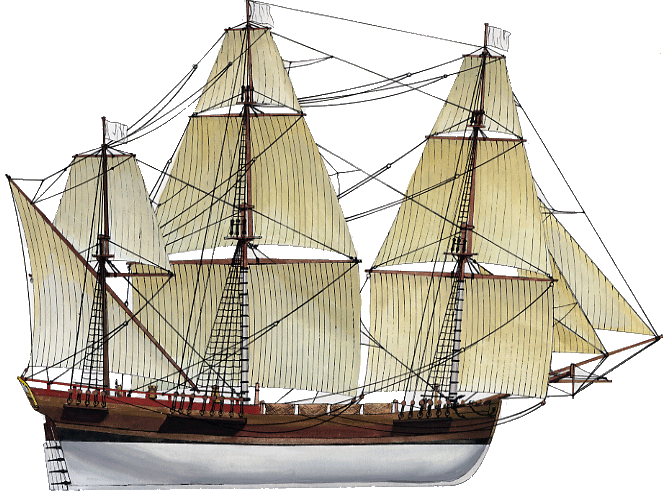
Elias Perryman must have been a mere 20 years of age, and presumably only recently deemed competent in seamanship as well as nautical astronomy when in February 1707 he was master of the Mary carrying, amongst other cargoes no doubt, “sundreys” from London for a Captain John Lane of Billerica, just north-east of Boston in the New England colony of Massachusetts. This was a long trip for one so early in his career. He was to be master of a succession of merchant ships that took him all over the European seas, across the Atlantic on several occasions and even as far as the west coast of Africa and, although they are seldom mentioned, the cargoes he transported varied from fine linen cloth to tobacco, bullion to tar and dried fruit to military personnel. The records that have enabled me to trace this remarkable life have been, principally, the London newspapers of the period in which the regular shipping news informed their readers what vessels and their masters had arrived or departed from the home ports and where they were coming from or going to. Towards the end of the period, from 1741 onwards, this information was published in the Lloyd’s Lists.
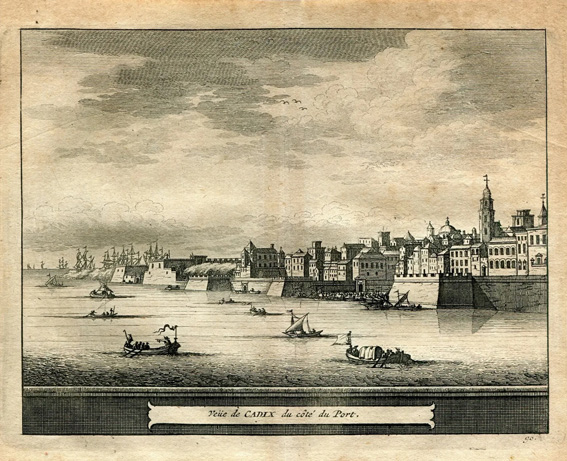
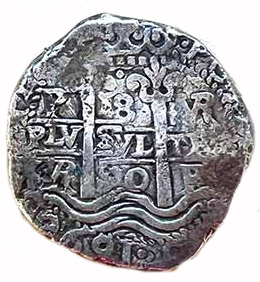
Elias’s voyage to Boston was not one that appeared in any of the papers but he first came to public notice as master of the Tyger in September 1718. Following the end of the War of the Spanish Succession in 1713 the Peace of Utrecht had ceded the Spanish Netherlands and Sardinia to Habsburg Austria and the Kingdom of Sicily to the Duchy of Savoy. Spain wanted to recover them and in 1717 it re-occupied Sardinia. In July 1718 Spanish troops landed on Sicily. The signatories to the Peace of Utrecht, which included Austria, Britain, France and the Dutch Republic, were determined to reassert the terms of the Peace. On the 11th of August a British naval squadron under Admiral George Byng destroyed the Spanish fleet off Cape Passaro, south of Sicily, depriving Spain’s forces on the island of naval support. When news eventually reached Madrid of the British victory the Spanish seized all the British ships then in their ports. The London papers reported that on the 11th of September Captain Perryman had set sail from Cadiz, narrowly avoiding having his ship impounded, and was thus able to return to London with his cargo of 200,000 Pieces of Eight, 80 chests of cochineal and a quantity of indigo. Three weeks later the papers made a point of announcing that The Tyger had arrived off Dover.
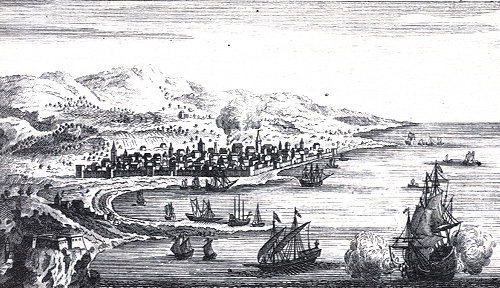
We hear of Captain Perryman again in May 1720 when he was in command of the Providence on a voyage to the Mediterranean. Passing through the Strait of Messina, between Sicily and the ‘toe of Italy’, the Providence and a number of other vessels were caught in a violent storm, forcing several of them to be beached. Most were able to be refloated but the London Journal reported that the Providence, which had been driven ashore at Reggio in Calabria, was feared lost.
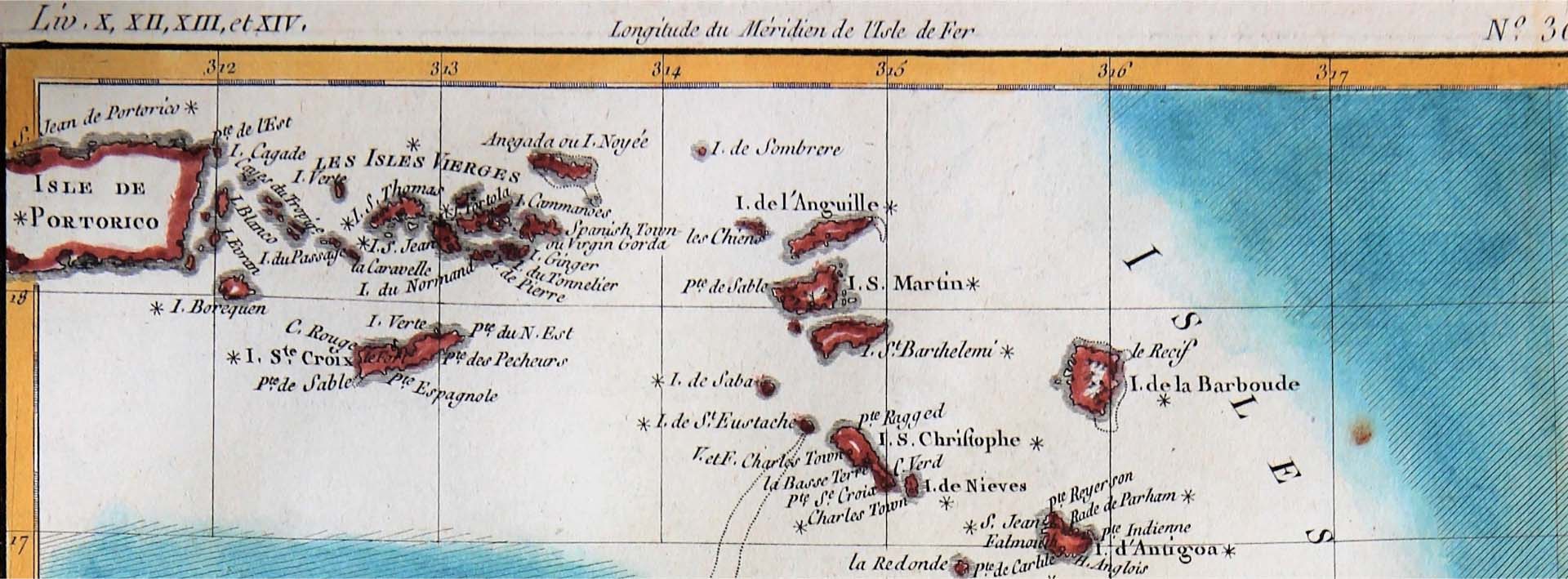
Elias was to make many trans-Atlantic crossings, both to the West Indies and to the British colonies in North America. In 1722 he was master of the Antegoa (an early name for Antigua) on a trip to Maryland, and two years later his destination was Antigua itself, in command of the Ormond setting sail from Dartmouth. The round trip would have taken several months as a subsequent voyage shows. For several years Elias was master of a ship called the Anna Maria and in November of 1725 he set off from Deal, where he had been awaiting favourable winds, bound for the island of St Christopher’s (now known as St Kitt’s). It was eight months before he arrived back in Gravesend. Return voyages from America generally took less time than those that were westbound because of the prevailing winds, so it is no surprise that while the Daily Journal reported that he had arrived in Antigua in early March 1727 he was back at Deal by the end of June after calling in at St Kitt’s. There was rarely a single destination on such trips, the cargoes he carried both outgoing and inbound being destined for many customers in several ports in the same part of the world. Also it is clear that often several ships would sail together, for company and protection, only to disperse for which ever port they were headed as they neared the end of their journey.
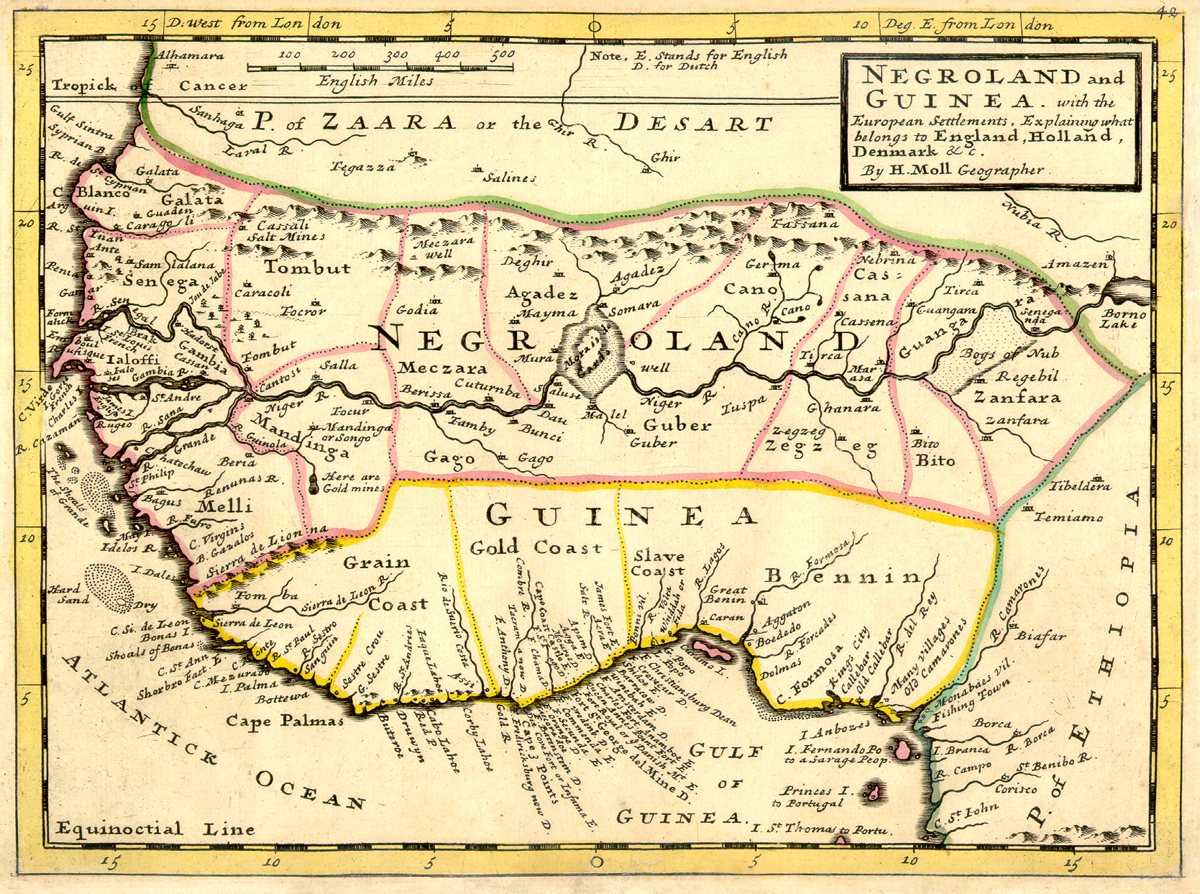
In September 1728 Elias was master of the Morris bound for Guinea. What his cargo was is not recorded but although Guinea, which then encompassed all the land along the southern coast of west Africa from modern Equatorial Guinea to Senegal, was notorious as the source of slaves for the Caribbean and the Americas, European states engaged in a great deal of trade with the kingdoms in the region, notably for gold, ivory, grain and pepper. In January 1731, this time in the Mary (probably not the same ship as in 1707), Elias was off to Guinea once more.
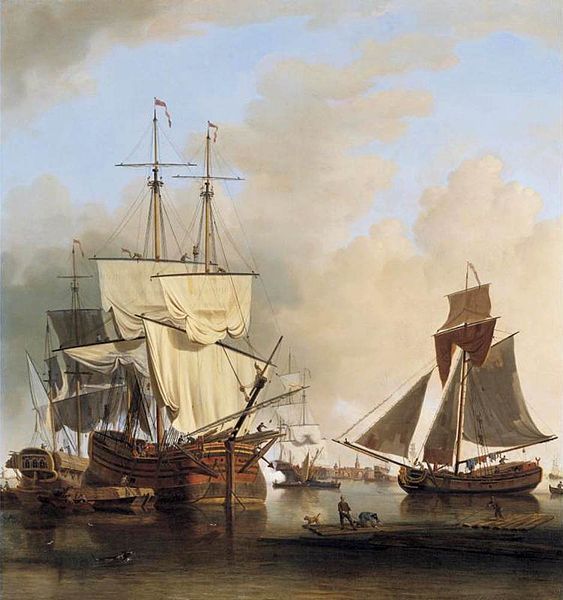
While the Mediterranean and the trans-Atlantic routes had largely been Elias’s stock-in-trade, he also visited north European ports. At the end of November 1730 Elias stopped off at Elsinore, Denmark, on the way back from a trip to St Petersburg, and a couple of weeks later he was in Plymouth taking the Prince William to Guernsey. In June 1731 he brought the same ship to Bristol with a cargo of cambric and brandy from Dunkirk, and a month later he was in Lisbon as master of the Princess Royal before another Dunkirk trip on the Prince William to Bristol, via Plymouth, in September. As master of the Princess Royal again, Elias was in Amsterdam in June of the next year where he was required to give evidence in a case of assault against a fellow sea captain, Robert Reaves, of the Experiment. In 1733 he went to Venice, calling in at Leghorn (Livorno) and Genoa.
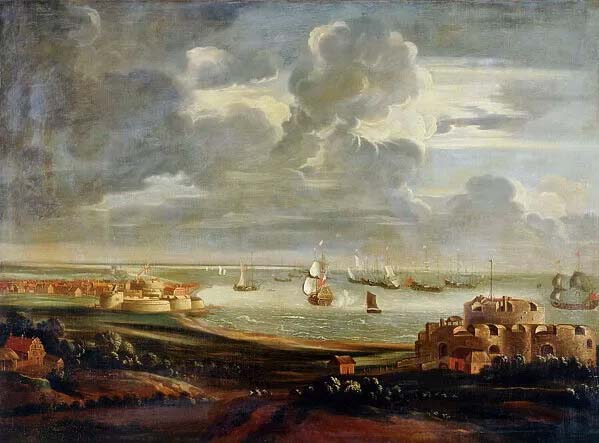
Nothing of Elias Perryman’s private life had been recorded so far. On the 26th of September 1735, describing himself as a gentleman and a resident of Deal, in Kent, he made his will and in it he left all his property, none of which was specified, to his wife Martha. I have been unable to find any record of their marriage but it is evident that she was the daughter of Nathan Brame, an Ostend merchant, and had been born in London in 1717, making her only 18 in 1735 and more than 20 years younger than her husband. In fact Elias was older than his father-in-law. The life of a mariner was a hazardous one and as much of his married life would be spent at sea, making his will when in good health would ensure the future security of his new bride and any children that would ensue. Indeed, about nine months later, in May of 1736, their eldest child was born at Deal. Named Nathan, after his grandfather, he was followed two years later by a second son, named after his father, but he died after only a couple of months. In 1740 Elias was off on the Italian Merchant to Stockholm, docking at Chatham in October with a cargo of tar. And the following year he left for Virginia in February, arriving back on the 1st of October, just in time for the birth of his third son, also named Elias, who was christened on the 15th at St Mary Magdalene’s in Bermondsey, where they had moved from Deal in the intervening period.
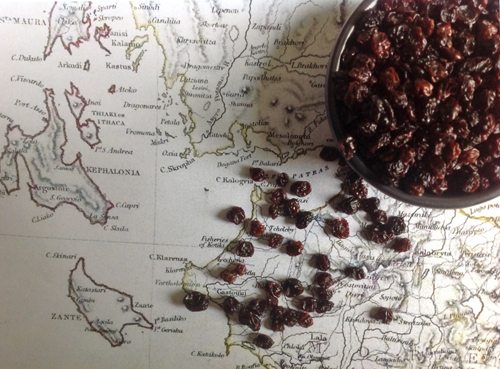
The voyage Elias embarked upon in June 1743 in the Italian Merchant, was to prove somewhat longer than might have been expected given that its destinations were all in the Mediterranean. Outward bound he was to visit Genoa before going on to Venice. Then he was to sail down the Adriatic to Kefalonia and Zante (Zakinthos) to take on board a cargo of currants, one of the principal products of those islands. Sailing back he came up against contrary winds in the western approaches which forced him to take shelter off Crookhaven, county Cork, a tiny settlement in the south-westernmost part of Ireland. Many of the Ottoman ports in the Mediterranean, which included the Ionian islands, had been stricken with outbreaks of the plague and the Privy Council had imposed a quarantine, originally of 40 days but by this time reduced to 14, on all ships returning from that area. So from Crookhaven the authorities ordered the Italian Merchant along the coast to the small port of Baltimore where the ship was placed in quarantine for a fortnight. Once released it arrived off the Downs on the 13th of March 1744 and was held in the Thames a week later while Treasury officials decided whether it needed to be quarantined again. Ships returning directly from infected ports had to anchor in Stangate Creek in the Medway estuary and the crews were neither allowed to go ashore nor anybody permitted to board the vessels during the quarantine period. Evidently the Italian Merchant was deemed safe and four days later was allowed to unload its cargo.
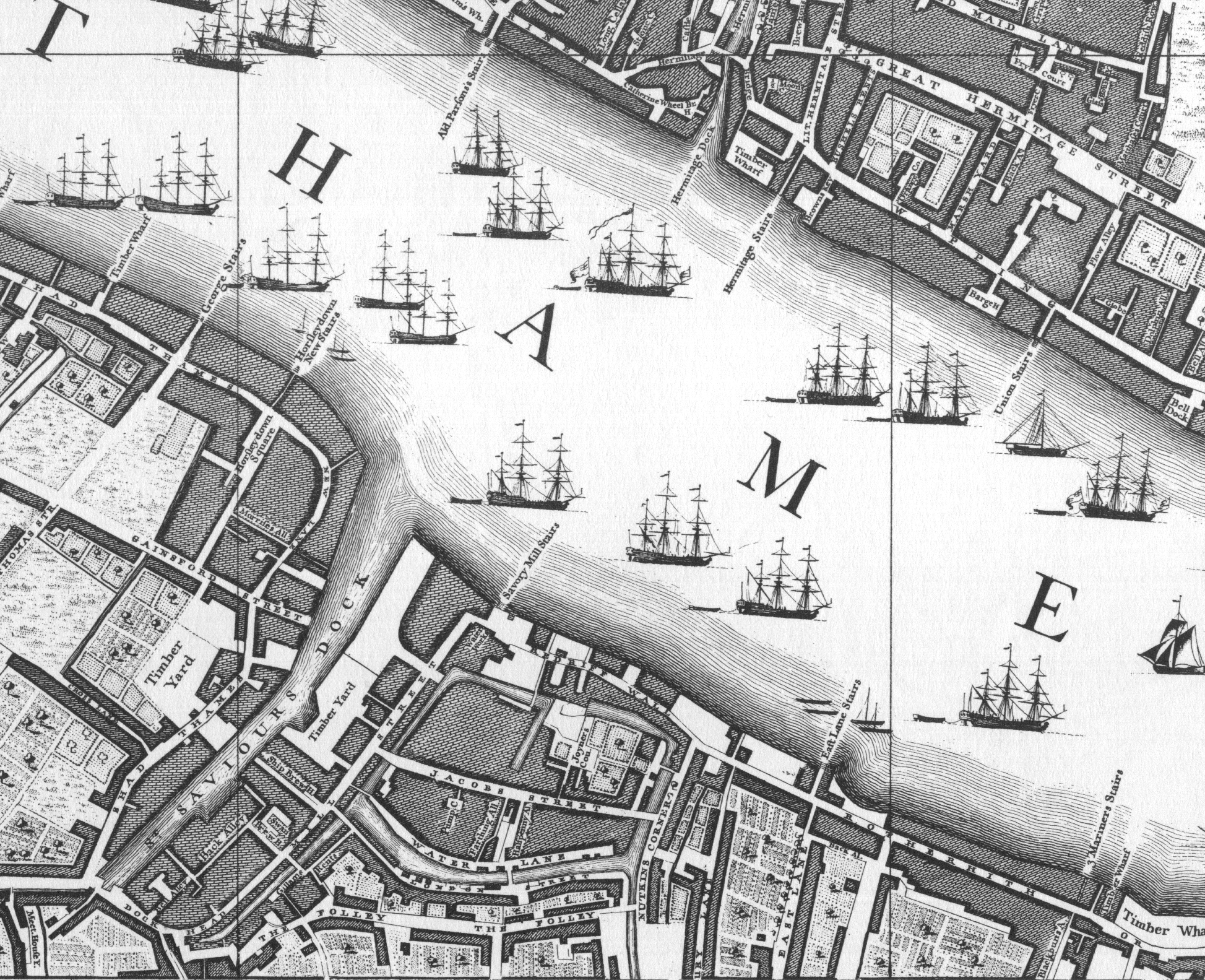
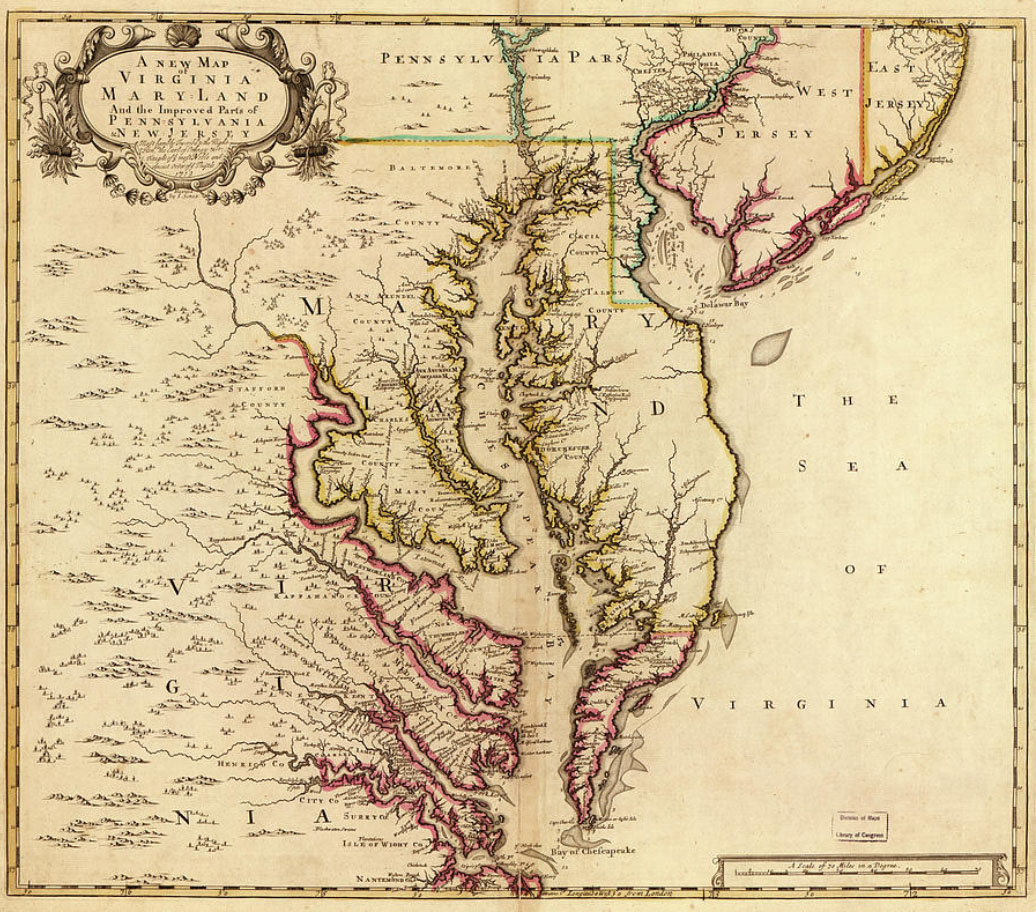
Martha gave birth to their fourth son, named Elias James, in April 1745 at their home in Jacobs Street, Bermondsey, and almost exactly two years later Thomas Perryman was born there too. One can only hope that Martha was well supported, looking after four boys aged from a newborn to an 11-year-old, because a month later, in May 1747, on a new vessel, the Beaufort, Elias took on troops and military stores at Woolwich for a voyage to Louisbourg on Cape Breton Island in Nova Scotia. The fort at Louisbourg had been built by the French to guard the entrance to the St Lawrence River. It had been captured by the British in 1745 and the soldiers on the Beaufort were being sent to reinforce the garrison there. Being a privately owned vessel, the Beaufort was to have a commercial role once the troops had been landed. Its owner, Henry Blommart, had contracted to take on a consignment of tobacco in Virginia and bring it back to England. After eventually sailing from the Downs on the 8th of June, Elias arrived at Cape Breton on the 17th of October. The Beaufort then proceeded down the coast of North America to the Potomac River, off Chesapeake Bay, reaching there on the 4th of December before turning south into the Rappahannock River. Elias moored the ship up the river at a place called Hob’s Hole, by a small settlement called Tappahannock and it was there, in early January that three of the crew jumped ship, taking with them a pinnace and some weapons. A pinnace is a boat that typically has a sail or several oars and its presence on the Beaufort gives some indication that it was a larger vessel than the merchantmen Elias had been accustomed to. He put an appeal in the local newspaper, the Maryland Gazette, for the recapture of the three who had absconded but whether they were is not known. After an extended stay on the east coast of America Elias called in at Waterford and Cork on the return journey, presumably to drop off, and perhaps take on, other cargo before arriving back at Gravesend on the 22nd of December 1748, a round trip of more than 18 months.
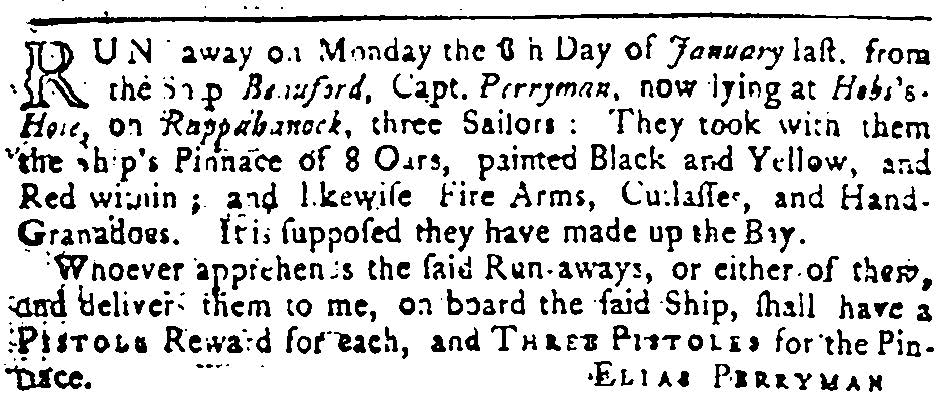
But that was not the end of the story. Henry Blommart, the owner of the Beaufort, had been contracted by the firm of Jonathan Sydenham and Thomas Hodgson, agents for the Virginia and Maryland trade, to have Elias collect some debts for them in Virginia. Evidently this had not happened so in April 1749 Sydenham and Hodgson sued Blommart in the Court of Chancery. Elias, apparently, refused to give a statement to the court apart from to confirm the arrangement. So Sydenham brought a case against Elias too.

Elias Perryman took the Beaufort back to Nova Scotia in 1749. Hired from Henry Blommart by the government, this time the ship was to carry settlers and it reached its destination in October. Once there, the newly-appointed Governor of Nova Scotia, Edward Cornwallis, hired the Beaufort, preventing its return, and kept it at anchor as a store ship at Chebuctu where he was starting to establish the port which would become Halifax, the future capital of the province. Because he was being required to stay in Nova Scotia for longer than he had anticipated, Elias, as master, incurred additional expenses to maintain the ship, and he called upon Henry Blommart to meet them. Blommart, in turn sought reimbursement from the Board of Trade in April 1751 for the hire of the ship by the Governor. Eventually the Beaufort was free to leave and arrived back in June 1750.
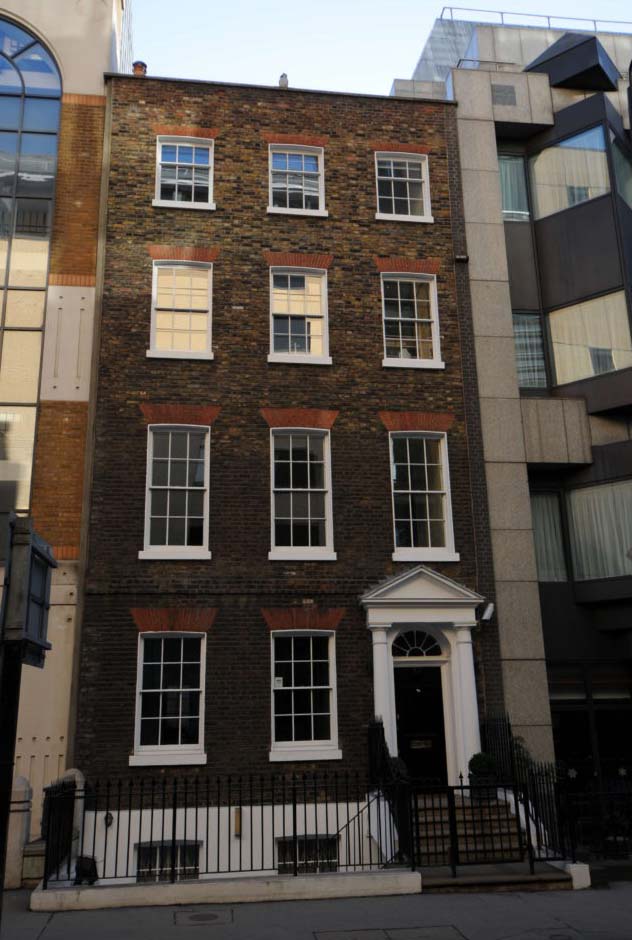
At around this time the Perryman family moved from Jacobs Street, Bermondsey, close to the River Thames, and took up residence in Prescot Street, Whitechapel, a much more salubrious address; Henry Blommart lived in the same street. And it was there that my great4-grandfather, Philip Thomas Perryman was born in December 1751.
The unsettled business following the trip to Virginia in 1748 dragged on. In 1752 Henry Blommart sued Elias, but the following year it was announced in the Gentleman’s Magazine that Blommart was bankrupt, so his cause was taken up by the assignees of his bankruptcy who proceeded to sue Elias for whatever Blommart had felt Elias had owed him. A detailed examination of the Chancery records would, no doubt, shed more light on what was being claimed and why. The souring of relations with Henry Blommart resulted in Elias taking command of a different vessel, the Fanny, for a trip to Newfoundland in 1753. He returned via Lisbon and almost immediately set off again in mid November, heading back to Lisbon before returning via Cork. This was to be Elias’s last voyage. On Thursday the 24th of January 1754 the London Evening Post printed the following:

He was 67 years old. When the same announcement was printed in the Kentish Weekly Post or Canterbury Journal a week later it added that he “had acquired a handsome fortune”.
Martha outlived him, dying in 1763, her will revealing a hitherto unrecorded daughter, Elizabeth, to whom she left all her worldly possessions. Judging by the fact that three of Elias’s sons, Nathan, Elias and Philip, became Ostend merchants it seems probable that they were taken under the wing of their grandfather Nathan Brame. Of the other two nothing further is known.
As a postscript, some 21 years after Elias’s death, a notice was published in the Daily Advertiser in August 1775 announcing: “If Mrs Perryman, widow of Capt. Elias Perryman, in the Virginia trade about the year 1750, or her Heirs, will apply at Mess. Hopkins & Co’s, No 36, Pater-noster Row, they may hear much to their Advantage, by a Gentleman just arrived from Virginia”.

[…] had been a sea captain, master of merchant ships carrying produce from mainly European ports (see Elias Perryman – sea […]